Key takeaways:
- Narrative structures enhance programming tutorials by combining clarity with emotional resonance, often following a three-act format: setup, confrontation, and resolution.
- Flexibility in narratives allows for adaptation based on learner feedback and promotes creativity, making the content more relatable and engaging.
- Incorporating real-world examples and personal anecdotes fosters connections with learners, transforming tutorials into engaging journeys.
- Visual aids and interactive tools, such as mind mapping and coding platforms, enhance the learning experience by making complex concepts more accessible.
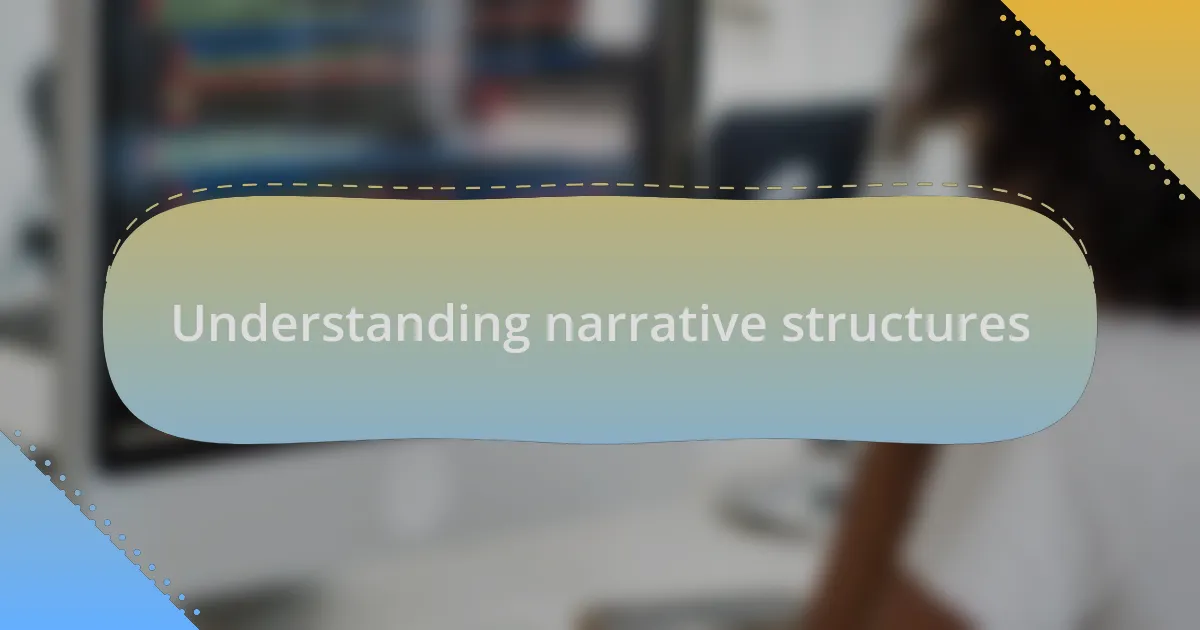
Understanding narrative structures
Narrative structures are essentially the frameworks that give stories their shape, guiding the trajectory from beginning to end. I remember the first time I grappled with structuring a narrative for a programming tutorial. It was a challenge to balance technical content with engaging storytelling—how do you keep the reader invested while ensuring they understand complex concepts?
At their core, these structures often follow a classic path, such as the three-act format: setup, confrontation, and resolution. I frequently ask myself—how can I create a sense of tension that leads to a satisfying conclusion? There’s an emotional resonance in watching a character or a problem evolve; it makes the learning experience not just informative but transformative.
Moreover, flexible narratives allow us to adapt as we gather feedback from learners. I once revised a tutorial based on comments and realized how my story developed a different, richer layer of understanding. Doesn’t it feel rewarding to see your narrative evolve through reader interaction? This adaptability can turn a straightforward tutorial into an engaging conversation, bridging the gap between rigid structure and creative storytelling.
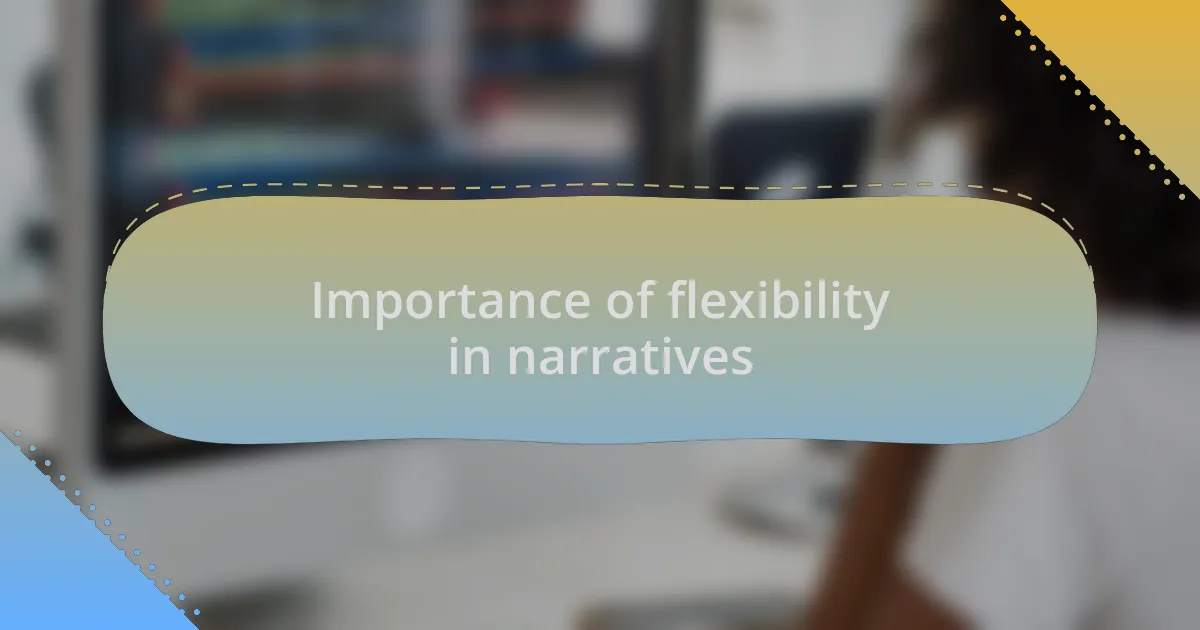
Importance of flexibility in narratives
The flexibility in narratives plays a crucial role in enhancing the learning experience. I recall a time when I received feedback that a specific tutorial felt too rigid. By incorporating the suggestions, I was able to change the flow, which not only made the content more approachable but also helped learners feel more like active participants. Isn’t it amazing how a slight shift can empower readers to connect more deeply with the material?
Allowing for flexibility means we can pivot as new technologies or techniques arise. When I first started teaching JavaScript, the landscape was constantly evolving. A flexible narrative enabled me to adjust my examples and explanations, keeping my content relevant and engaging. I often wonder—if I hadn’t been willing to adapt, how many eager learners might have been left behind?
Moreover, a flexible approach encourages creativity in storytelling. I find it invigorating to weave real-time coding challenges into my tutorials, allowing learners to see the narrative unfold in a way that feels personal and relatable. How can we expect to inspire curiosity without giving ourselves the freedom to explore various paths? Flexibility allows us to create narratives that resonate on multiple levels, facilitating a richer understanding of programming concepts.
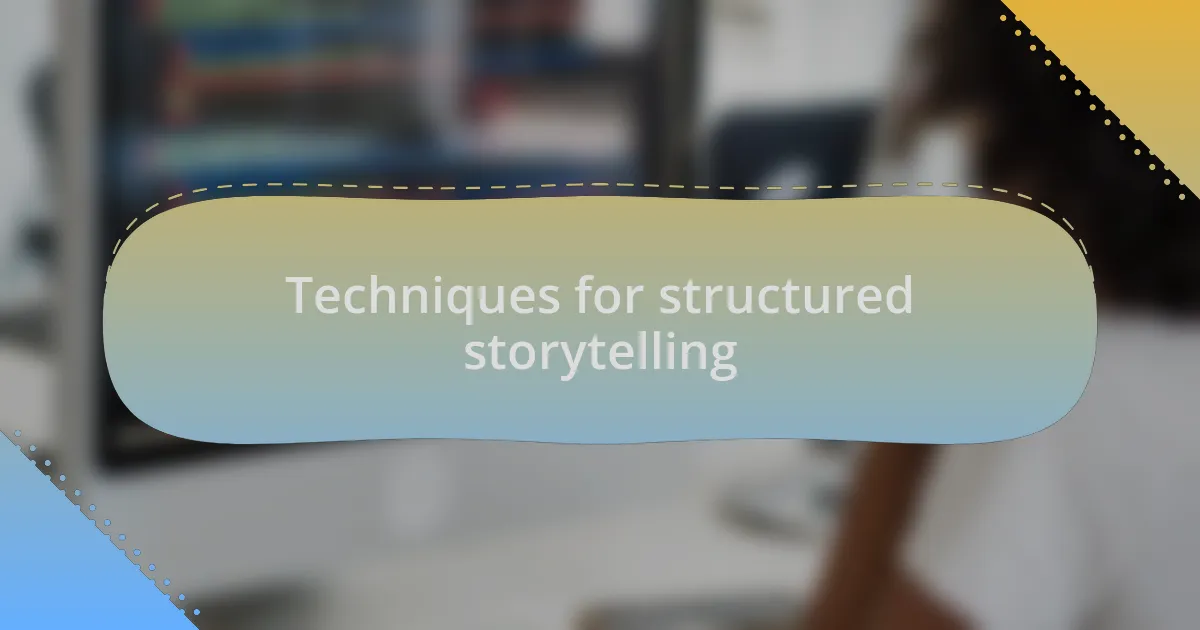
Techniques for structured storytelling
Structured storytelling in programming tutorials can significantly enhance clarity and comprehension. One technique I often use is the “three-act structure,” which mirrors the storytelling form popular in literature and film. By presenting a clear setup, conflict, and resolution, I engage learners right from the start. Reflecting on my early tutorials, I noticed how this format not only kept the material organized but also guided students through problem-solving in a way that felt familiar.
Another approach I find effective is the use of storytelling arcs within each tutorial. For instance, consider framing a concept like asynchronous programming as a journey. I once compared it to cooking where you can’t just put everything in the pot at once; you have to allow certain ingredients time to cook. That analogy caught my students’ attention and made the seemingly complex idea much more approachable. How does thinking of coding like a culinary adventure change our perception of problem-solving in programming?
Incorporating real-world examples as a backbone for the narrative can also create depth. I remember sharing a project I worked on involving API integration that had me facing challenges I had not anticipated. This not only made my storytelling more authentic but also provided learners with a sense of connection. By walking them through my thought process, I empowered them to tackle their own coding obstacles—after all, who hasn’t stumbled upon an unexpected bug during development? Sharing those moments of vulnerability fosters a supportive learning environment and reinforces the importance of structured yet flexible narratives.
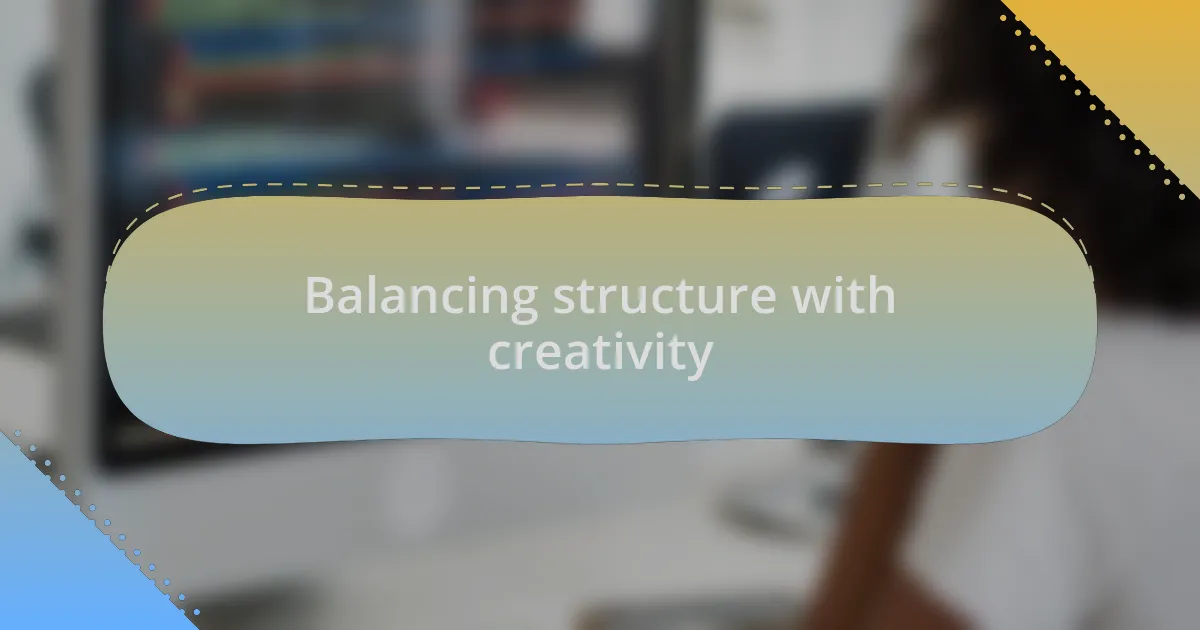
Balancing structure with creativity
Balancing structure with creativity in programming tutorials often feels like walking a tightrope. When I design a course, I strive for a clear framework but allow space for spontaneous exploration. I recall a time when I opened up a session for a Q&A, and one student’s question sparked a whole new direction for the lesson that day. It not only enriched the discussion but also underscored the beauty of adaptable teaching.
Creativity flourishes within the confines of structure. For example, while I maintain a standardized format for my lessons, I frequently weave in unexpected analogies or humorous anecdotes to keep students engaged. One time, I likened debugging to hunting for treasure; that twist helped my learners view challenges from a lighter perspective. Doesn’t it feel good to discover something unexpected amidst a structured path?
Ultimately, the art of storytelling lies in blending predictability with surprise. Whenever I sense my audience drifting, I inject an interactive element—like a live coding challenge or a group brainstorming session. This dynamic approach transforms rigid lesson plans into vibrant, collaborative experiences. By allowing ourselves to embrace both method and imagination, we create a richer narrative that resonates deeply with learners.
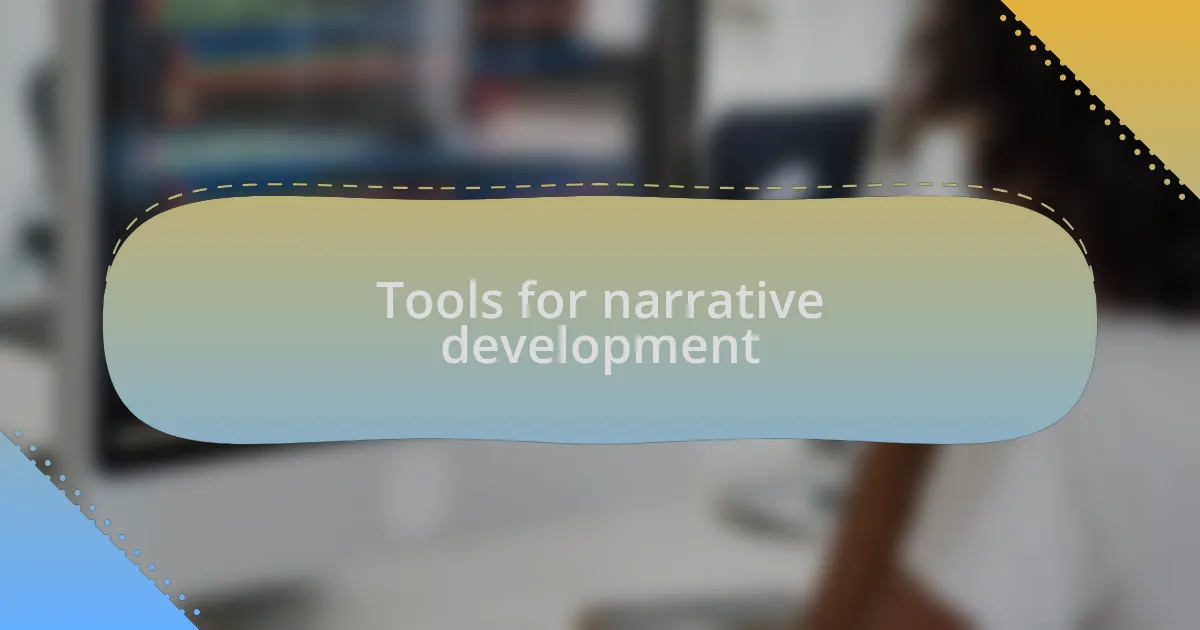
Tools for narrative development
Tools for narrative development play a crucial role in crafting engaging programming tutorials. One tool I often turn to is mind mapping software, which helps me visually organize the flow of topics. I remember when I was plotting out a lesson on algorithms; the visual framework allowed me to see connections I might have missed otherwise. Doesn’t it feel rewarding to visualize how each concept builds on the previous one?
Another invaluable tool is interactive coding platforms, which encourage learners to apply what they’ve just learned. I’ve had students use applications like Replit to experiment in real-time as we discuss various programming concepts. This immediate feedback loop creates a narrative that evolves as they encounter problems, making their learning experience both structured and exciting. How often do you discover new insights while actively engaging with the material?
Lastly, utilizing storyboarding techniques can significantly enhance narrative clarity. When I prepare tutorials, I sketch out the key milestones in a lesson, ensuring that each component flows logically to the next. I once created a storyboard for a series on web development, and it was fascinating to see how a simple outline could transform an idea into a cohesive narrative. Have you ever tried visualizing your lessons this way? It might surprise you how much more intuitive your content can become.
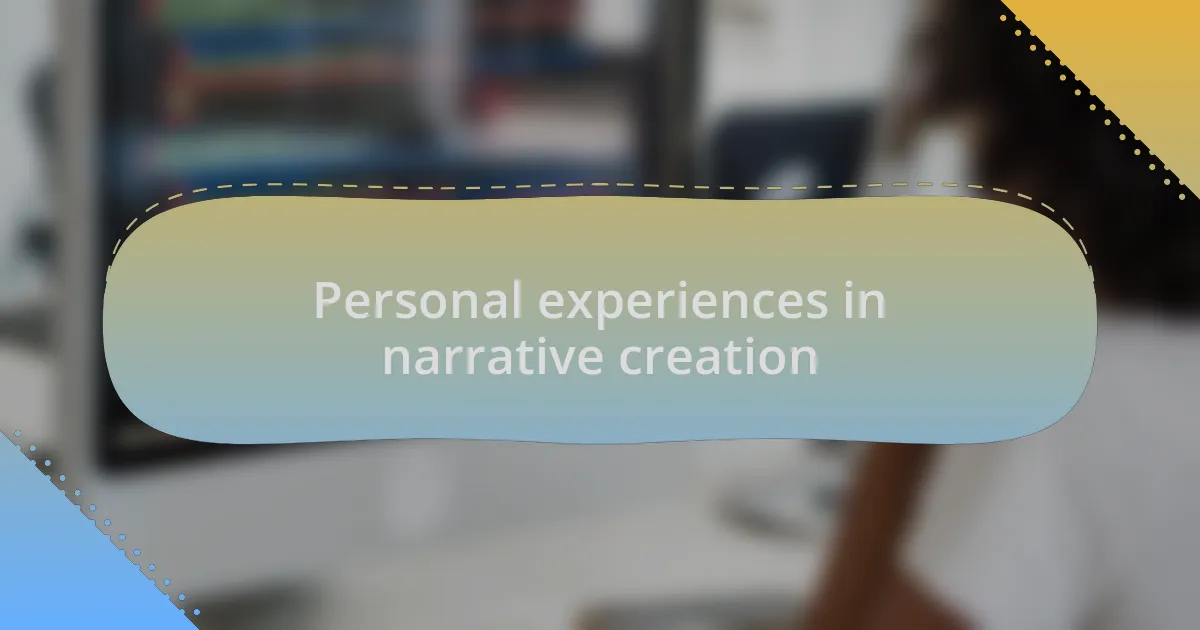
Personal experiences in narrative creation
When I first started crafting narratives for programming tutorials, I often relied heavily on scripts—painfully detailed outlines that felt more like chains than guides. I remember one particular instance where I strictly adhered to my script during a live session, only to find that my audience had questions that veered completely off course. The experience taught me that flexibility within a structured framework is essential. It’s liberating to let the conversation flow naturally while still guiding the learners through the material.
One of my favorite moments in narrative creation happened during a workshop on object-oriented programming. I decided to share a personal story about my first encounter with classes and objects, highlighting my struggles and eventual breakthroughs. The way my audience resonated with my narrative left a lasting impression on me. It made me realize that vulnerability can forge stronger connections with learners, turning a simple tutorial into an engaging journey. Don’t you find that personal anecdotes can often breathe life into otherwise dry subjects?
I’ve also learned that allowing space for exploration within my narratives fosters creativity. For example, in a recent tutorial on frontend frameworks, I introduced a scenario where participants could create their own project, choosing their tech stack along the way. This approach not only enhanced their engagement but also encouraged them to take ownership of their learning experience. Can there be a greater thrill than witnessing learners dive into their projects with enthusiasm, all sparked by the narrative you crafted?
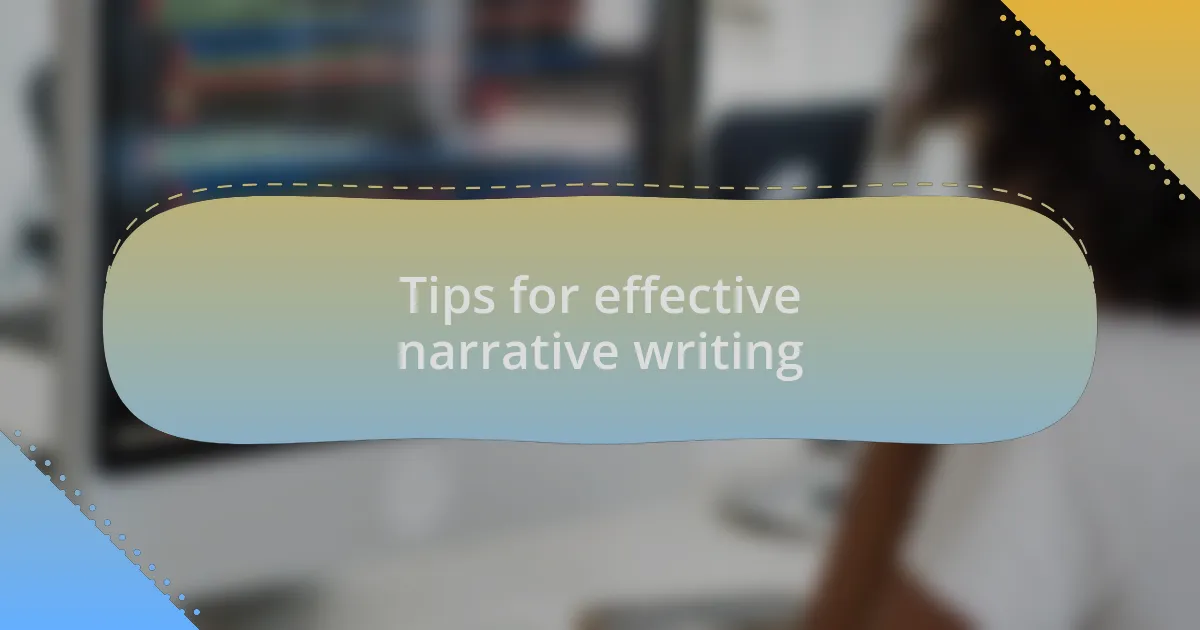
Tips for effective narrative writing
Finding the right balance between structure and flexibility is crucial in narrative writing. When I crafted a series of tutorials on asynchronous programming, I structured the material but left room for spontaneous questions. I recall a moment where a learner asked about real-life applications of callbacks, which led to a rich discussion that deepened everyone’s understanding. Have you ever recognized that those off-script moments can often lead to the most valuable insights?
Another effective tip is to weave in storytelling elements to create emotional connections. In one instance, while explaining error handling, I shared a story about a time I crashed a production server due to an overlooked bug. The levity that emerged from my embarrassment not only lightened the mood but also underscored the importance of proper error management. Isn’t it fascinating how vulnerability can turn a technical explanation into a memorable lesson?
Utilizing visual aids can also enhance narrative effectiveness. During a tutorial on responsive design, I incorporated diagrams to illustrate concepts such as media queries. The clear visuals transformed abstract ideas into tangible examples, helping participants visualize their learning. I often wonder how many learners benefit from a well-placed graphic that clarifies complex information. By engaging multiple senses, we’re painting a fuller picture in their minds.